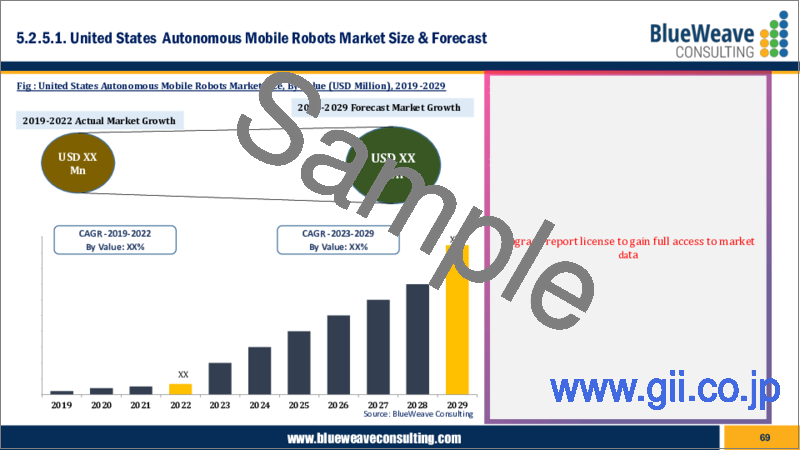|
|
市場調査レポート
商品コード
1391770
自律移動ロボット市場- 世界の規模、シェア、動向分析、機会、予測レポート、2018-2028年Autonomous Mobile Robots Market - Global Size, Share, Trend Analysis, Opportunity and Forecast Report, 2018-2028, Segmented By Type ; By Application ; By Battery Type ; By End Use (Manufacturing, Warehouse & Distribution Centers ); By Region |
||||||
|
|||||||
| 自律移動ロボット市場- 世界の規模、シェア、動向分析、機会、予測レポート、2018-2028年 |
|
出版日: 2023年11月13日
発行: Blueweave Consulting
ページ情報: 英文 400 Pages
納期: 2~3営業日
|
- 全表示
- 概要
- 目次
自律移動ロボットの世界市場規模は2.7倍に拡大、CAGRは17.7%と堅調、2029年には481億6,000万米ドルに達する
自律移動ロボットの世界市場は、製造業や物流業などさまざまな産業で、業務効率の向上や人件費の削減を目的とした自動化に対する需要がますます高まっていることから、活況を呈しています。技術の進歩、費用対効果の高いソリューション、より安全で柔軟なロボットシステムへのニーズが、市場の成長をさらに後押ししています。
戦略コンサルティングと市場調査の大手企業であるBlueWeave Consulting社は、最近の調査で、2022年の世界の自律移動ロボット(AMR)市場規模を21億5,000万米ドルと推定しました。2023年から2029年にかけての予測期間中、BlueWeaveは世界の自律移動ロボット市場規模が17.71%の堅調なCAGRで成長し、2029年には57億2,000万米ドルに達すると予測しています。自律移動ロボットの世界市場は、製造業、物流、ヘルスケアなど、AMRが業務を合理化し、人件費を削減できるさまざまな産業で、自動化と効率化の需要が高まっていることなど、いくつかの重要な要因によって主に牽引されています。ナビゲーション、AI、センサー技術の技術的進歩も、AMRの能力とコスト効率を高めています。また、COVID-19の大流行による社会的距離の必要性と人的介入の減少が、AMRの採用を加速させています。さらに、持続可能性と環境への関心の高まりが、資源利用の最適化とエネルギー消費の削減を目的としたAMRの利用を促進しています。
本レポートの詳細な分析により、世界の自律移動ロボット市場の成長可能性、今後の動向、統計に関する情報を提供します。また、総市場規模の予測を促進する要因も取り上げています。当レポートは、世界の自律移動ロボット市場の最新技術動向と、意思決定者が健全な戦略的意思決定を行うための業界洞察を提供することをお約束します。さらに、市場の成長促進要因・課題・競争力についても分析しています。
目次
第1章 調査の枠組み
第2章 エグゼクティブサマリー
第3章 世界の自律移動ロボット市場に関する洞察
- 業界のバリューチェーン分析
- DROC分析
- 成長促進要因
- 業界全体での高い自動化導入率
- 業界全体でオートメーションとロボティクスへの需要の高まり
- 人工知能と機械学習テクノロジーの進歩
- 抑制要因
- 初期費用が高い
- 離職と労働力の再訓練に関する懸念
- 機会
- ヘルスケアおよび医療分野での自律移動ロボットの採用増加
- 倉庫や物流管理におけるロボットの需要
- 課題
- 自律移動ロボットの機能についての認識と理解
- 既存のロボット企業と新規参入者との競合
- 成長促進要因
- 技術の進歩/最近の開発
- 規制の枠組み
- ポーターのファイブフォース分析
第4章 世界の自律移動ロボット市場概要
- 市場規模と予測、2019~2029年
- 金額別
- 市場シェアと予測
- タイプ別
- GTPピッキングロボット
- 自動運転フォークリフト
- 自律型在庫ロボット
- 無人航空機
- 用途別
- 仕分け
- ピック&プレイス
- 引っ張る
- 倉庫フリート管理
- その他
- 電池タイプ別
- 鉛電池
- リチウムイオン電池
- ニッケルベース電池
- その他
- 最終用途別
- 製造業
- 自動車
- 航空宇宙
- エレクトロニクス
- 化学薬品
- 医薬品
- プラスチック
- 防衛
- 日用消費財
- その他
- 倉庫および配送センター
- eコマース
- 小売店チェーン/コンビニエンスストア
- その他
- 地域別
- 北米
- 欧州
- アジア太平洋(APAC)
- ラテンアメリカ(LATAM)
- 中東およびアフリカ(MEA)
- タイプ別
第5章 北米の自律移動ロボット市場
- 市場規模と予測、2019~2029年
- 金額別
- 市場シェアと予測
- タイプ別
- 用途別
- 電池タイプ別
- 最終用途別
- 国別
- 米国
- カナダ
第6章 欧州の自律移動ロボット市場
- 市場規模と予測、2019~2029年
- 金額別
- 市場シェアと予測
- タイプ別
- 用途別
- 電池タイプ別
- 最終用途別
- 国別
- ドイツ
- 英国
- イタリア
- フランス
- スペイン
- ベルギー
- ロシア
- オランダ
- その他欧州
第7章 アジア太平洋の自律移動ロボット市場
- 市場規模と予測、2019~2029年
- 金額別
- 市場シェアと予測
- タイプ別
- 用途別
- 電池タイプ別
- 最終用途別
- 国別
- 中国
- インド
- 日本
- 韓国
- オーストラリアとニュージーランド
- インドネシア
- マレーシア
- シンガポール
- ベトナム
- その他
第8章 ラテンアメリカの自律移動ロボット市場
- 市場規模と予測、2019~2029年
- 金額別
- 市場シェアと予測
- タイプ別
- 用途別
- 電池タイプ別
- 最終用途別
- 国別
- ブラジル
- メキシコ
- アルゼンチン
- ペルー
- その他
第9章 中東およびアフリカの自律移動ロボット市場
- 市場規模と予測、2019~2029年
- 金額別
- 市場シェアと予測
- タイプ別
- 用途別
- 電池タイプ別
- 最終用途別
- 国別
- サウジアラビア
- アラブ首長国連邦
- カタール
- クウェート
- 南アフリカ
- ナイジェリア
- アルジェリア
- その他
第10章 競合情勢
- 主要企業とその製品のリスト
- 世界の自律移動ロボット市場シェア分析、2022年
- 経営パラメータによる競合ベンチマーキング
- 主要な戦略的展開(合併、買収、パートナーシップなど)
第11章 世界の自律移動ロボット市場に対するCOVID-19の影響
第12章 企業プロファイル(会社概要、財務マトリックス、競合情勢、主要人材、主要競合、連絡先住所、戦略的展望、 SWOT分析)
- ABB Ltd.
- Amazon Robotics
- Clearpath Robotics
- Daifuku Co., Ltd.
- Fanuc Corporation
- Fetch Robotics, Inc.
- GreyOrange Pte Ltd.
- KION Group AG
- KUKA AG
- Locus Robotics
- Omron Adept Technologies
- Rethink Robotics
- Seegrid Corporation
- SoftBank Robotics
- Yaskawa Electric Corporation
- その他の主要企業
第13章 主要な戦略的推奨事項
第14章 調査手法
Global Autonomous Mobile Robots Market Size Zooming 2.7X at Robust CAGR of 17.7% to Reach USD 48.16 Billion by 2029.
Global autonomous mobile robots market is flourishing due to an increasingly high demand for automation in various industries, such as manufacturing and logistics, to improve operational efficiency and reduce labor costs. Technological advancements, cost-effective solutions, and the need for safer and more flexible robotic systems further fuel market growth.
BlueWeave Consulting, a leading strategic consulting and market research firm, in its recent study, estimated the global autonomous mobile robots (AMRs) market size at USD 2.15 billion in 2022. During the forecast period between 2023 and 2029, BlueWeave expects the global autonomous mobile robots market size to grow at a robust CAGR of 17.71% reaching a value of USD 5.72 billion by 2029. The global autonomous mobile robots market is being primarily driven by several key factors, including a growing demand for automation and efficiency across various industries, such as manufacturing, logistics, and healthcare, where AMRs can streamline operations and reduce labor costs. Technological advancements in navigation, AI, and sensor technologies have also made AMRs more capable and cost-effective. Also, the need for social distancing and reduced human intervention due to the COVID-19 pandemic has accelerated the adoption of AMRs. Further, the increasing emphasis on sustainability and environmental concerns is promoting the use of AMRs to optimize resource utilization and reduce energy consumption.
Autonomous Mobile Robots - Overview
Autonomous mobile robots are self-operating machines equipped with sensors, AI, and mobility capabilities, enabling them to navigate and perform tasks without human intervention. They find applications in various industries, such as manufacturing, logistics, agriculture, and healthcare. These robots use sensors like cameras and LiDAR to perceive their environment, process data using artificial intelligence, and make decisions to move, manipulate objects, or complete assigned missions. Their tasks range from goods transportation and warehouse automation to surveillance and search and rescue operations. Autonomous mobile robots hold the potential to enhance efficiency, reduce labor costs, and improve safety in a wide range of operational settings.
Impact of COVID-19 on Global Autonomous Mobile Robots Market
COVID-19 pandemic significantly impacted the global autonomous mobile robots market. With social distancing and hygiene measures crucial in various industries, autonomous mobile robots have gained prominence in tasks like disinfection, logistics, and healthcare. These robots reduce human interaction, ensuring safer environments. While the pandemic initially disrupted supply chains and manufacturing, the market has since rebounded, driven by increased demand for automation solutions. Post-pandemic, the market continues to expand as businesses recognize the benefits of integrating autonomous robots, leading to sustained growth and reshaping the industry for the long term.
Global Autonomous Mobile Robots Market - By Battery Type
By battery type, the global autonomous mobile robots market is divided into Lead Battery, Lithium-Ion Battery, and Nickel-based Battery segments. The lithium-ion battery segment is the largest, signifying the market's shift towards more energy-efficient and durable power sources. Lithium-ion batteries offer enhanced performance and longer lifespan, making them a popular choice for powering autonomous mobile robots across various industries, from manufacturing to logistics. The segment's dominance underscores the growing demand for efficient and sustainable energy solutions in the field of autonomous robotics.
Competitive Landscape
Global autonomous mobile robots market is fiercely competitive. Major companies in the market include ABB Ltd, Amazon Robotics, Clearpath Robotics, Daifuku Co., Ltd, Fanuc Corporation, Fetch Robotics, Inc., GreyOrange Pte Ltd, KION Group AG, KUKA AG, Locus Robotics, Omron Adept Technologies, Rethink Robotics, Seegrid Corporation, SoftBank Robotics, and Yaskawa Electric Corporation. These companies use various strategies, including increasing investments in their R&D activities, mergers, and acquisitions, joint ventures, collaborations, licensing agreements, and new product and service releases to further strengthen their position in global autonomous mobile robots market.
The in-depth analysis of the report provides information about growth potential, upcoming trends, and statistics of Global Autonomous Mobile Robots Market. It also highlights the factors driving forecasts of total Market size. The report promises to provide recent technology trends in Global Autonomous Mobile Robots Market and industry insights to help decision-makers make sound strategic decisions. Furthermore, the report also analyzes the growth drivers, challenges, and competitive dynamics of the market.
Table of Contents
1. Research Framework
- 1.1. Research Objective
- 1.2. Product Overview
- 1.3. Market Segmentation
2. Executive Summary
3. Global Autonomous Mobile Robots Market Insights
- 3.1. Industry Value Chain Analysis
- 3.2. DROC Analysis
- 3.2.1. Growth Drivers
- 3.2.1.1. High adoption rate of automation across industry verticals
- 3.2.1.2. Increasing demand for automation and robotics across industries.
- 3.2.1.3. Advancements in artificial intelligence and machine learning technologies.
- 3.2.2. Restraints
- 3.2.2.1. High initial costs
- 3.2.2.2. Concerns regarding job displacement and workforce retraining.
- 3.2.3. Opportunities
- 3.2.3.1. Increasing adoption of autonomous mobile robots in healthcare and medical sectors.
- 3.2.3.2. Growing demand for robots in warehouse and logistics management.
- 3.2.4. Challenges
- 3.2.4.1. Limited awareness and understanding of autonomous mobile robot capabilities.
- 3.2.4.2. Competition from established robotics companies and new market entrants.
- 3.2.1. Growth Drivers
- 3.3. Technological Advancements/Recent Developments
- 3.4. Regulatory Framework
- 3.5. Porter's Five Forces Analysis
- 3.5.1. Bargaining Power of Suppliers
- 3.5.2. Bargaining Power of Buyers
- 3.5.3. Threat of New Entrants
- 3.5.4. Threat of Substitutes
- 3.5.5. Intensity of Rivalry
4. Global Autonomous Mobile Robots Market Overview
- 4.1. Market Size & Forecast, 2019-2029
- 4.1.1. By Value (USD Billion)
- 4.2. Market Share and Forecast
- 4.2.1. By Type
- 4.2.1.1. Goods-to-Person Picking Robots
- 4.2.1.2. Self-Driving Forklifts
- 4.2.1.3. Autonomous Inventory Robots
- 4.2.1.4. Unmanned Aerial Vehicles
- 4.2.2. By Application
- 4.2.2.1. Sorting
- 4.2.2.2. Pick & Place
- 4.2.2.3. Tugging
- 4.2.2.4. Warehouse Fleet Management
- 4.2.2.5. Others
- 4.2.3. By Battery Type
- 4.2.3.1. Lead Battery
- 4.2.3.2. Lithium-Ion Battery
- 4.2.3.3. Nickel-based Battery
- 4.2.3.4. Others
- 4.2.4. By End Use
- 4.2.4.1. Manufacturing
- 4.2.4.1.1. Automotive
- 4.2.4.1.2. Aerospace
- 4.2.4.1.3. Electronics
- 4.2.4.1.4. Chemical
- 4.2.4.1.5. Pharmaceuticals
- 4.2.4.1.6. Plastics
- 4.2.4.1.7. Defense
- 4.2.4.1.8. FMCG
- 4.2.4.1.9. Others
- 4.2.4.2. Warehouse & Distribution Centers
- 4.2.4.2.1. E-commerce
- 4.2.4.2.2. Retail Chains/Conveyance Stores
- 4.2.4.2.3. Others
- 4.2.5. By Region
- 4.2.5.1. North America
- 4.2.5.2. Europe
- 4.2.5.3. Asia Pacific (APAC)
- 4.2.5.4. Latin America (LATAM)
- 4.2.5.5. Middle East and Africa (MEA)
- 4.2.1. By Type
5. North America Autonomous Mobile Robots Market
- 5.1. Market Size & Forecast, 2019-2029
- 5.1.1. By Value (USD Billion)
- 5.2. Market Share & Forecast
- 5.2.1. By Type
- 5.2.2. By Application
- 5.2.3. By Battery Type
- 5.2.4. By End Use
- 5.2.5. By Country
- 5.2.5.1. United States
- 5.2.5.1.1. By Type
- 5.2.5.1.2. By Application
- 5.2.5.1.3. By Battery Type
- 5.2.5.1.4. By End Use
- 5.2.5.2. Canada
- 5.2.5.2.1. By Type
- 5.2.5.2.2. By Application
- 5.2.5.2.3. By Battery Type
- 5.2.5.2.4. By End Use
6. Europe Autonomous Mobile Robots Market
- 6.1. Market Size & Forecast, 2019-2029
- 6.1.1. By Value (USD Billion)
- 6.2. Market Share & Forecast
- 6.2.1. By Type
- 6.2.2. By Application
- 6.2.3. By Battery Type
- 6.2.4. By End Use
- 6.2.5. By Country
- 6.2.5.1. Germany
- 6.2.5.1.1. By Type
- 6.2.5.1.2. By Application
- 6.2.5.1.3. By Battery Type
- 6.2.5.1.4. By End Use
- 6.2.5.2. United Kingdom
- 6.2.5.2.1. By Type
- 6.2.5.2.2. By Application
- 6.2.5.2.3. By Battery Type
- 6.2.5.2.4. By End Use
- 6.2.5.3. Italy
- 6.2.5.3.1. By Type
- 6.2.5.3.2. By Application
- 6.2.5.3.3. By Battery Type
- 6.2.5.3.4. By End Use
- 6.2.5.4. France
- 6.2.5.4.1. By Type
- 6.2.5.4.2. By Application
- 6.2.5.4.3. By Battery Type
- 6.2.5.4.4. By End Use
- 6.2.5.5. Spain
- 6.2.5.5.1. By Type
- 6.2.5.5.2. By Application
- 6.2.5.5.3. By Battery Type
- 6.2.5.5.4. By End Use
- 6.2.5.6. Belgium
- 6.2.5.6.1. By Type
- 6.2.5.6.2. By Application
- 6.2.5.6.3. By Battery Type
- 6.2.5.6.4. By End Use
- 6.2.5.7. Russia
- 6.2.5.7.1. By Type
- 6.2.5.7.2. By Application
- 6.2.5.7.3. By Battery Type
- 6.2.5.7.4. By End Use
- 6.2.5.8. The Netherlands
- 6.2.5.8.1. By Type
- 6.2.5.8.2. By Application
- 6.2.5.8.3. By Battery Type
- 6.2.5.8.4. By End Use
- 6.2.5.9. Rest of Europe
- 6.2.5.9.1. By Type
- 6.2.5.9.2. By Application
- 6.2.5.9.3. By Battery Type
- 6.2.5.9.4. By End Use
7. Asia-Pacific Autonomous Mobile Robots Market
- 7.1. Market Size & Forecast, 2019-2029
- 7.1.1. By Value (USD Billion)
- 7.2. Market Share & Forecast
- 7.2.1. By Type
- 7.2.2. By Application
- 7.2.3. By Battery Type
- 7.2.4. By End Use
- 7.2.5. By Country
- 7.2.5.1. China
- 7.2.5.1.1. By Type
- 7.2.5.1.2. By Application
- 7.2.5.1.3. By Battery Type
- 7.2.5.1.4. By End Use
- 7.2.5.2. India
- 7.2.5.2.1. By Type
- 7.2.5.2.2. By Application
- 7.2.5.2.3. By Battery Type
- 7.2.5.2.4. By End Use
- 7.2.5.3. Japan
- 7.2.5.3.1. By Type
- 7.2.5.3.2. By Application
- 7.2.5.3.3. By Battery Type
- 7.2.5.3.4. By End Use
- 7.2.5.4. South Korea
- 7.2.5.4.1. By Type
- 7.2.5.4.2. By Application
- 7.2.5.4.3. By Battery Type
- 7.2.5.4.4. By End Use
- 7.2.5.5. Australia & New Zealand
- 7.2.5.5.1. By Type
- 7.2.5.5.2. By Application
- 7.2.5.5.3. By Battery Type
- 7.2.5.5.4. By End Use
- 7.2.5.6. Indonesia
- 7.2.5.6.1. By Type
- 7.2.5.6.2. By Application
- 7.2.5.6.3. By Battery Type
- 7.2.5.6.4. By End Use
- 7.2.5.7. Malaysia
- 7.2.5.7.1. By Type
- 7.2.5.7.2. By Application
- 7.2.5.7.3. By Battery Type
- 7.2.5.7.4. By End Use
- 7.2.5.8. Singapore
- 7.2.5.8.1. By Type
- 7.2.5.8.2. By Application
- 7.2.5.8.3. By Battery Type
- 7.2.5.8.4. By End Use
- 7.2.5.9. Vietnam
- 7.2.5.9.1. By Type
- 7.2.5.9.2. By Application
- 7.2.5.9.3. By Battery Type
- 7.2.5.9.4. By End Use
- 7.2.5.10. Rest of APAC
- 7.2.5.10.1. By Type
- 7.2.5.10.2. By Application
- 7.2.5.10.3. By Battery Type
- 7.2.5.10.4. By End Use
8. Latin America Autonomous Mobile Robots Market
- 8.1. Market Size & Forecast, 2019-2029
- 8.1.1. By Value (USD Billion)
- 8.2. Market Share & Forecast
- 8.2.1. By Type
- 8.2.2. By Application
- 8.2.3. By Battery Type
- 8.2.4. By End Use
- 8.2.5. By Country
- 8.2.5.1. Brazil
- 8.2.5.1.1. By Type
- 8.2.5.1.2. By Application
- 8.2.5.1.3. By Battery Type
- 8.2.5.1.4. By End Use
- 8.2.5.2. Mexico
- 8.2.5.2.1. By Type
- 8.2.5.2.2. By Application
- 8.2.5.2.3. By Battery Type
- 8.2.5.2.4. By End Use
- 8.2.5.3. Argentina
- 8.2.5.3.1. By Type
- 8.2.5.3.2. By Application
- 8.2.5.3.3. By Battery Type
- 8.2.5.3.4. By End Use
- 8.2.5.4. Peru
- 8.2.5.4.1. By Type
- 8.2.5.4.2. By Application
- 8.2.5.4.3. By Battery Type
- 8.2.5.4.4. By End Use
- 8.2.5.5. Rest of LATAM
- 8.2.5.5.1. By Type
- 8.2.5.5.2. By Application
- 8.2.5.5.3. By Battery Type
- 8.2.5.5.4. By End Use
9. Middle East & Africa Autonomous Mobile Robots Market
- 9.1. Market Size & Forecast, 2019-2029
- 9.1.1. By Value (USD Billion)
- 9.2. Market Share & Forecast
- 9.2.1. By Type
- 9.2.2. By Application
- 9.2.3. By Battery Type
- 9.2.4. By End Use
- 9.2.5. By Country
- 9.2.5.1. Saudi Arabia
- 9.2.5.1.1. By Type
- 9.2.5.1.2. By Application
- 9.2.5.1.3. By Battery Type
- 9.2.5.1.4. By End Use
- 9.2.5.2. UAE
- 9.2.5.2.1. By Type
- 9.2.5.2.2. By Application
- 9.2.5.2.3. By Battery Type
- 9.2.5.2.4. By End Use
- 9.2.5.3. Qatar
- 9.2.5.3.1. By Type
- 9.2.5.3.2. By Application
- 9.2.5.3.3. By Battery Type
- 9.2.5.3.4. By End Use
- 9.2.5.4. Kuwait
- 9.2.5.4.1. By Type
- 9.2.5.4.2. By Application
- 9.2.5.4.3. By Battery Type
- 9.2.5.4.4. By End Use
- 9.2.5.5. South Africa
- 9.2.5.5.1. By Type
- 9.2.5.5.2. By Application
- 9.2.5.5.3. By Battery Type
- 9.2.5.5.4. By End Use
- 9.2.5.6. Nigeria
- 9.2.5.6.1. By Type
- 9.2.5.6.2. By Application
- 9.2.5.6.3. By Battery Type
- 9.2.5.6.4. By End Use
- 9.2.5.7. Algeria
- 9.2.5.7.1. By Type
- 9.2.5.7.2. By Application
- 9.2.5.7.3. By Battery Type
- 9.2.5.7.4. By End Use
- 9.2.5.8. Rest of MEA
- 9.2.5.8.1. By Type
- 9.2.5.8.2. By Application
- 9.2.5.8.3. By Battery Type
- 9.2.5.8.4. By End Use
10. Competitive Landscape
- 10.1. List of Key Players and Their Offerings
- 10.2. Global Autonomous Mobile Robots Market Share Analysis, 2022
- 10.3. Competitive Benchmarking, By Operating Parameters
- 10.4. Key Strategic Developments (Mergers, Acquisitions, Partnerships, etc.)
11. Impact of Covid-19 on Global Autonomous Mobile Robots Market
12. Company Profile (Company Overview, Financial Matrix, Competitive Landscape, Key Personnel, Key Competitors, Contact Address, Strategic Outlook, SWOT Analysis)
- 12.1. ABB Ltd.
- 12.2. Amazon Robotics
- 12.3. Clearpath Robotics
- 12.4. Daifuku Co., Ltd.
- 12.5. Fanuc Corporation
- 12.6. Fetch Robotics, Inc.
- 12.7. GreyOrange Pte Ltd.
- 12.8. KION Group AG
- 12.9. KUKA AG
- 12.10. Locus Robotics
- 12.11. Omron Adept Technologies
- 12.12. Rethink Robotics
- 12.13. Seegrid Corporation
- 12.14. SoftBank Robotics
- 12.15. Yaskawa Electric Corporation
- 12.16. Other Prominent Players
13. Key Strategic Recommendations
14. Research Methodology
- 14.1. Qualitative Research
- 14.1.1. Primary & Secondary Research
- 14.2. Quantitative Research
- 14.3. Market Breakdown & Data Triangulation
- 14.3.1. Secondary Research
- 14.3.2. Primary Research
- 14.4. Breakdown of Primary Research Respondents, By Region
- 14.5. Assumptions & Limitations





